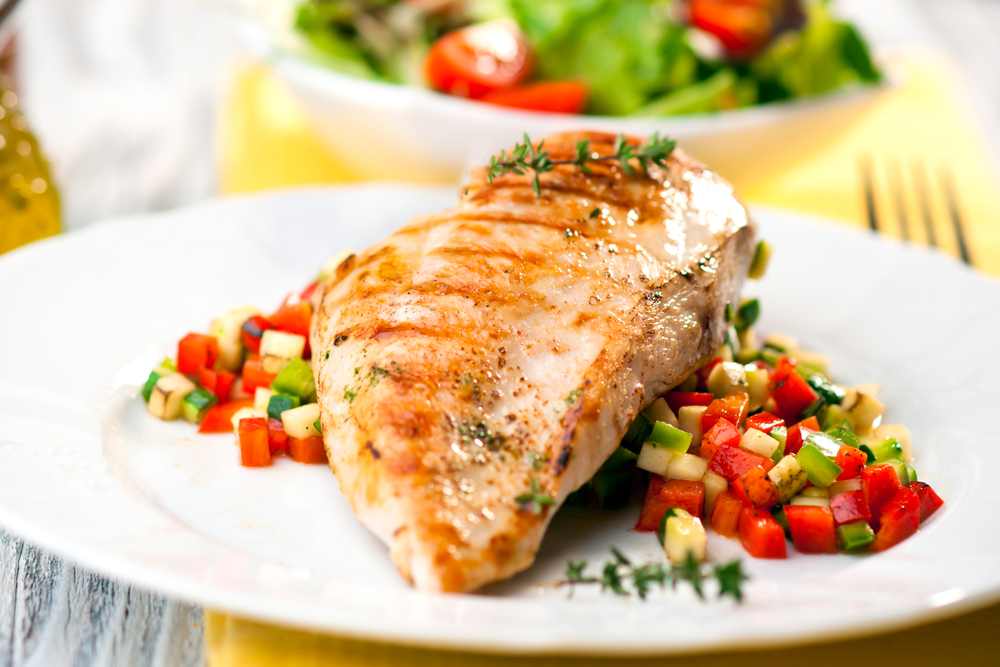Nutrition plays an essential role during an athlete’s rehabilitation period, especially for wound healing. The key nutrients involved in wound healing include protein, carbohydrates, essential fatty acids, and a variety of vitamins, and minerals. If one of these nutrients is lacking in the athlete’s diet, delayed wound healing may result, thereby postponing the athlete’s return to training and/or competition.
Three important nutrition points to practice when recovering from an injury include the following:
1. Do not over-indulge or excessively calorie-restrict. During the rehabilitation period, an athlete’s daily caloric needs are less than what they were prior to the injury, due to a decrease in energy expenditure or fitness level. If the athlete does not compensate for this decrease, weight gain may result in the form of fat tissue. Extra body fat places additional stress on the injured joints and will impede upon the athletes’ sports performance. On the other hand, some athletes aggressively restrict their caloric intake in fear of gaining weight. This is more detrimental to the athlete than overeating, because calorie-restriction deprives the body of nutrients, especially protein, a catalyst in the healing process.
2. Incorporate the “powerhouse foods” into your meal plan. *Protein Protein is one of the most important nutrients for wound healing and plays several key roles for the body such as repairing tissue, fighting infection, and performing regulatory functions. The BEST absorbed proteins are the high biological value (HBV) proteins, which are derived from animals, with the exception of soy, and include lean meats, poultry without the skin, fish, shellfish, dairy products, and eggs. The lower biological value (LBV) proteins are derived from plants and are not as well absorbed by the body. These include grains, vegetables, legumes, beans, and lentils. *Carbohydrates are the body’s preferred and cleanest fuel source. The athlete needs to eat adequate amounts of carbohydrates so that protein can do its job. The bulk of carbohydrates in the diet should come from whole-grains, fruits, vegetables, legumes, beans, and lentils.
*Essential fatty acids, otherwise known as omega-3’s and omega-6’s, are required for normal growth and the maintenance of cell membranes, healthy arteries, and nerve tissue. Since the body cannot make these types of fats on its own, they must be obtained from food. Omega 3’s are found in oily fish such as mackerel, salmon, sardines, and herring, as well as in green leafy vegetables, nuts, canola oil, and tofu. Omega-6’s are found in vegetable oils, which are hidden in the majority of pre-packaged or pre-prepared foods. The goal is to eat more omega 3’s than omega’6’s.
*Calcium If calcium intake is insufficient, the healing process will be impaired, placing the athlete at an increase risk for weakened bones and stress fractures. Calcium is found in dairy products and green leafy vegetables. When choosing dairy, choose non-fat or low-fat.
*Beta Carotene and Vitamin A Beta-carotene is converted into vitamin A in the body and enhances the inflammatory response, stimulates cell formation, and supports the immune system. Beta-carotene is found in carrots, sweet potatoes, spinach, cantaloupe, broccoli, and dark leafy greens. Vitamin A is found in liver, egg yolks, whole milk, and orange and yellow vegetables.
*Vitamin C aids in the synthesis of collagen formation, a core component of scar tissue and is found in citrus fruits and juices, peppers, cabbage, kiwi, cantaloupe, and leafy greens.
*B Vitamins The athletes’ B vitamin needs are increased due to an elevated metabolism as a result of the healing process. A few of these B vitamins include B1 or thiamin found in brewer’s yeast, wheat germ, bran, whole grains, and organ meats; B2 or riboflavin found in milk, eggs, lean meats, and broccoli; B3 or niacin found in lean meats, liver, poultry, fish, peanuts, and wheat germ; B12 found in meats, dairy products, eggs, liver, and fish; and folic acid or folate found in fortified breakfast cereals, green leafy vegetables, and liver.
3. Supplement as needed. In addition to eating a diet consisting of the “powerhouse foods,” athletes may wish to supplement their diets with the following for insurance purposes. Remember to always check with a physician before taking supplements. -A daily antioxidant multiple containing 100% of the daily values for vitamins and minerals -Calcium: 1000-1500 mg / day from food and supplements -Vitamin C: 100 mg two times / day -Zinc: 25 mg / day -Vitamin E: 200-400 IU / day of the natural form (d-tocopherol) Athletes who consistently push themselves hard during training and competition are at an increase risk for injury and therefore must endure the rehabilitation period. For this reason, it is imperative that athletes pay as close attention, if not more, to their diets as they do to their fitness and training programs. Many athletes strive for that perfect physique while not practicing healthful eating habits and behaviors. Following an optimal sports diet minimizes the length of rehab and moreover, decreases an athlete’s risk of injury in the first place.
The following is a recipe containing many of the “powerhouse foods,” which is ideal for not only injury and rehab, but for sports performance as well. Barth’s Powerhouse Formula Ingredients ¾ cup frozen, unsweetened mixed berries 4 oz low-fat mixed berry yogurt 1 T whey protein (or the equivalent to 15 grams of protein) 1 T honey 1 T flax seeds, ground or flax seed oil ½ cup low-fat (1%) milk ½ cup calcium-fortified orange juice Ice cubes as desired Directions Blend first 7 ingredients together until smooth. Add ice cubes as desired.
Yields: 1 serving Nutritional Information Calories: 480 Carbohydrates: 68 grams (57%) Protein: 28 grams (23%) Fat: 10 grams (20%) References: 1. Kleiner, SM. Power Eating 2nd ed. Champaign, Ill: Human Kinetics; 2001. 2. Rosenbloom C. Sports Nutrition A Guide for the Professional Working with Active People 3rd ed. Chicago Ill: American Dietetic Association. 2000.
-SportExcel Health and Human Performance, Chrissy Barth, RD, CFT

